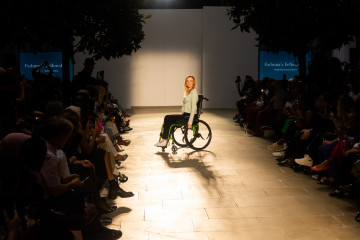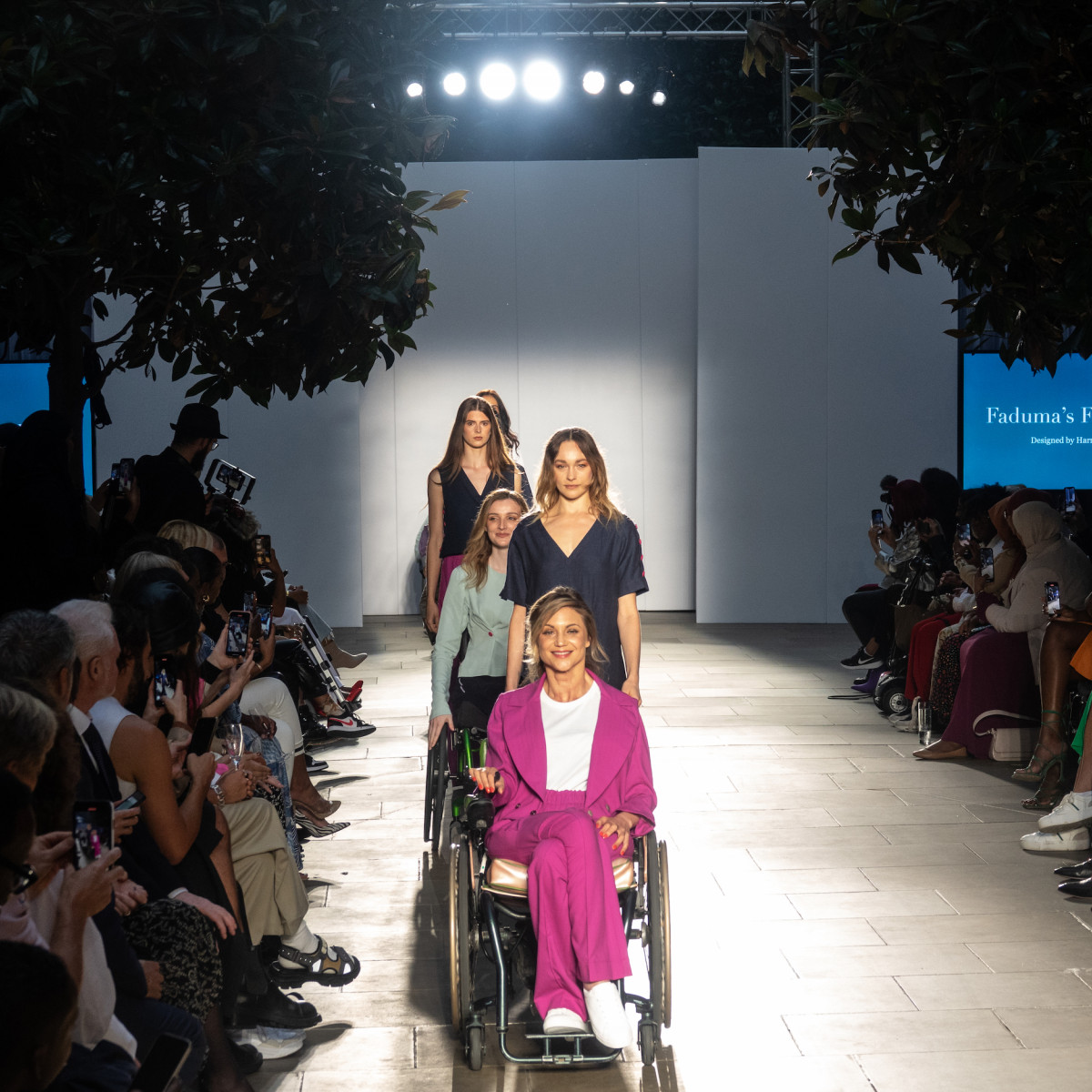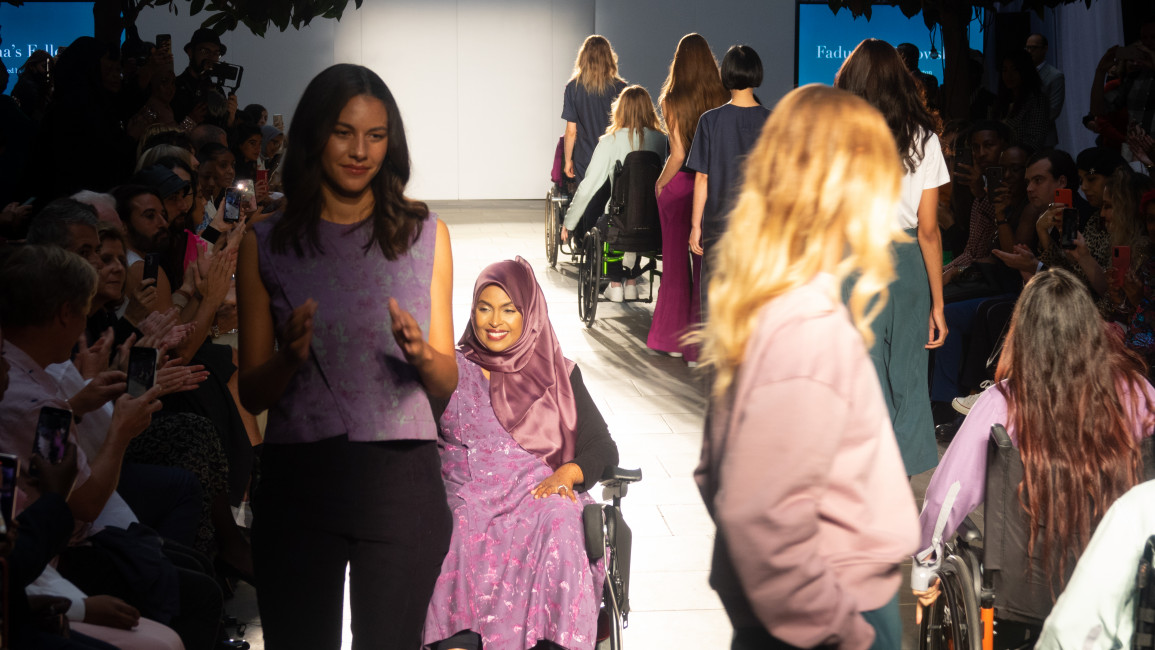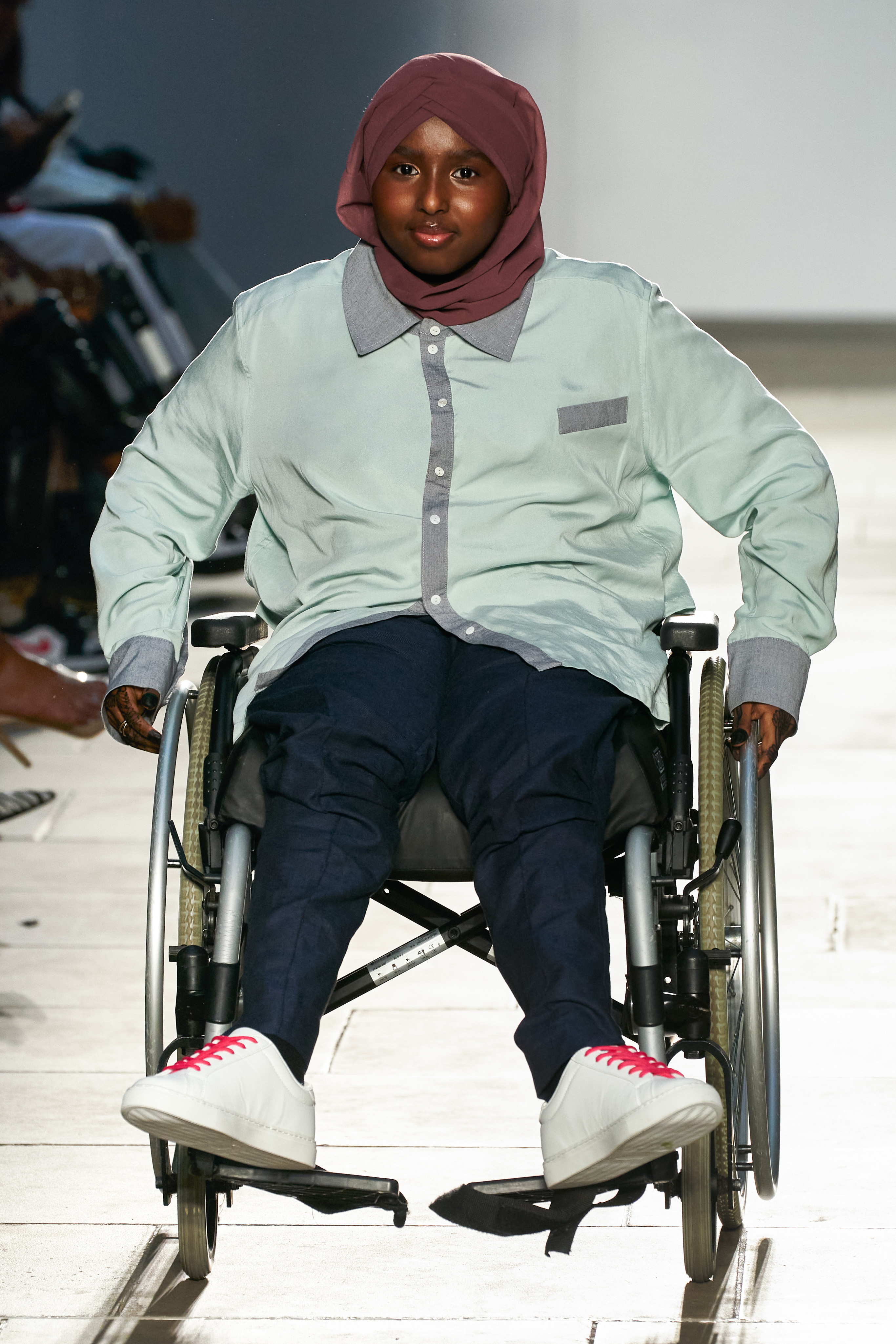

The pioneering work of British-Somali visionary Faduma Farah ignited a watershed moment in the fashion industry when models rolled down the catwalk in wheelchairs for the first time in the history of London Fashion Week in September.
The 45-year-old first spoke with The New Arab in June this year when she was at the height of running ‘Faduma’s Fellowship’ – a campaign to find a designer to co-create a collection of adapted clothing for people with disabilities – a vision she realised while paralysed from the neck down after being struck with meningitis.
Some five months to the day since she launched the campaign with Oxford Fashion Studio, Faduma witnessed her vision come to life as models with disabilities radiated with pride along the runway to rapturous applause.
And afterwards, as she approached the microphone to share her thoughts, Faduma beamed with pride too.
In fact, you could be forgiven for not detecting the emotional and physical distress that she has endured in the months that led to this moment; months during which she was both bedridden with sores and grief-stricken after tragically losing her mother, Qarshi Jama, to pneumonia – all the while, orchestrating the campaign from her bed.
Yet in the face of it all, Faduma’s endurance has continued to shine: “We had to go on, we couldn’t stop, so I took Zoom meetings from my bed – it just made me realise that technology is so amazing.”
| Models on the catwalk paraded both adapted and non-adapted fashion [Shashi Shukla] |
| Faduma Farah addresses the audience after the show [Shashi Shukla] |
Still, the air at LFW was thick with emotion and there was not a dry eye in the place as Faduma delivered her words, calling out the fashion industry for its lack of inclusivity and the time it has taken to take stock of the fact that people with disabilities have the right to feel amazing too.
Addressing the audience, she said: “As wheelchair users, we have a lot of hurdles in life and dressing up should not be part of that. It is our right to feel fabulous. I would like every designer out there to think about the person in the wheelchair. Don’t forget, this is England, 21st century. Why is it just now? Did I have to be in a wheelchair so I could produce a line?
“Today, we have opened a door. Hopefully, there will be many more designers out there, designing for the person in the wheelchair. We can do this. Let’s do this.”
Faduma’s mother – or ‘hooyo’ as she is called in Somali – stepped in when fashion let her down: assuring her daughter she could still be beautiful, still be fashionable, and still be fabulous.
"Today, we have opened a door. Hopefully, there will be many more designers out there, designing for the person in the wheelchair. We can do this. Let’s do this"
A testament to this was visible on a space next to the catwalk entrance where her mother’s words were projected to honour her legacy for inspiring Faduma’s vision. Words, which she tells me, that still ring true: “My darling daughter, who are you waiting for? If you want a change, it has to start with you dear.” The tribute was followed by a personal note from Faduma, telling her mother: “Hooyo, we made it.”
The following day, as she decompressed from the excitement of her show, Faduma told The New Arab: “I am thanking the almighty Allah for giving me the opportunity to be able to do amazing things. When you see the crowd cheering for models rolling wheelchairs down that runway, when your collection is displayed for all to see, and when you all feel flamboyant as everyone watches you - it becomes a moment where you feel proud to be disabled.”
But she said despite the enormity of the message behind the event, media attention had been sparse.
She added: “This was the first time ever that wheelchair fashion was launched at LFW. How come it was not seen on mainstream media? Is it because this is not important to them?”
| Faduma joins her models on the catwalk [Shashi Shukla] |
| Faduma Farah and Harriet Eccleston pose for pictures after the show [Shashi Shukla] |
The collection, co-created with winning designer Harriet Eccleston boasted features both functional and fashionable: crease-resistant and breathable powerhouse suits with bold colours, clean lines and soft, shimmering, seamless fabrics were adapted with bespoke magnets, pockets and zips for easy wear, dressing and undressing.
The designer deployed the extensive research of twins Reb and Melissa Everett who had delivered a final year project on adaptive clothing at Manchester Metropolitan University two years ago after working with the Stroke Association.
"It didn’t take long to realise people with disabilities don’t feel heard in fashion. We’ve met people of all abilities: some wear catheters, so this required accessible trousers without a zip. Others have the use of one arm, which would mean adapting a t shirt for easy wear"
Harriet told The New Arab: “At first, I thought: I can’t do this, I’m not the right designer for this collection because I don’t have that understanding. But then I asked myself: “why don’t I have that understanding?’ I thought I was running an inclusive label, but it turns out I wasn’t, so I decided to find out how to change this.”
Reb added: “During our research, it didn’t take long to realise people with disabilities don’t feel heard in fashion. We’ve met people of all abilities: some wear catheters, so this required accessible trousers without a zip. Others have the use of one arm, which would mean adapting a t-shirt for easy wear.”
The twins felt that without design skills, they were not able to take their project any further. Melissa added: “We went to university with Harriet and she approached us about our research. We didn’t realise our work would be brought to the surface again as we didn’t know where to take it. So to have this opportunity to use it has really been so amazing. We just want this to be a cluster of change.”
The global market for adaptable fashion has been predicted to reach an estimated $400 billion by 2026 (Coherent Market Insights).
Yet the fashion industry has been seemingly slow to catch on. Model and social media influencer Carla Holmes aka Rollin Funky told The New Arab: “Today was more important than people realise. I am a frequent visitor of LFW but I have not seen clothing adapted like this. It’s very much needed. We are part of society, we need to be represented.”
Faduma’s LFW show is being viewed as a pivotal moment for the fashion industry in the UK and beyond, attracting attention from fashion schools in New York and Sydney where her tour du force approach has made her an ambassador of adapted clothing for a new generation of designers.
Najma Samamtar, the youngest model to roll down the catwalk on Sunday, would welcome such change. The 18-year old childcare student who lives with a rare genetic disorder known as Arginase Deficiency told The New Arab: “I love the colours and designs, I found them very easy to put on. I like fashion because it’s nice to wear nice clothes.”
| Najma Samamtar was the youngest model on the catwalk [Oxford Fast House] |
Faduma said hearing such young people in wheelchairs speak of fashion in this way was empowering in itself. She added: “I feel like we have opened the door. The sky is the limit and this is just the beginning. There is still so much more to come.”
Anu Shukla is a freelance journalist based in London.
Follow her on Twitter: @AnuShuklaWrites











